This is a big project that I (and a small team) have been working on for quite a while.
My "client" (also a friend) wanted me to design a big system which can utilize his "good stuff". And he got a partner in business who is a very skillful carpenter, so he urged me to design something not only sounds good but also delivers some visual impact.
So here is, a 3way horn system:
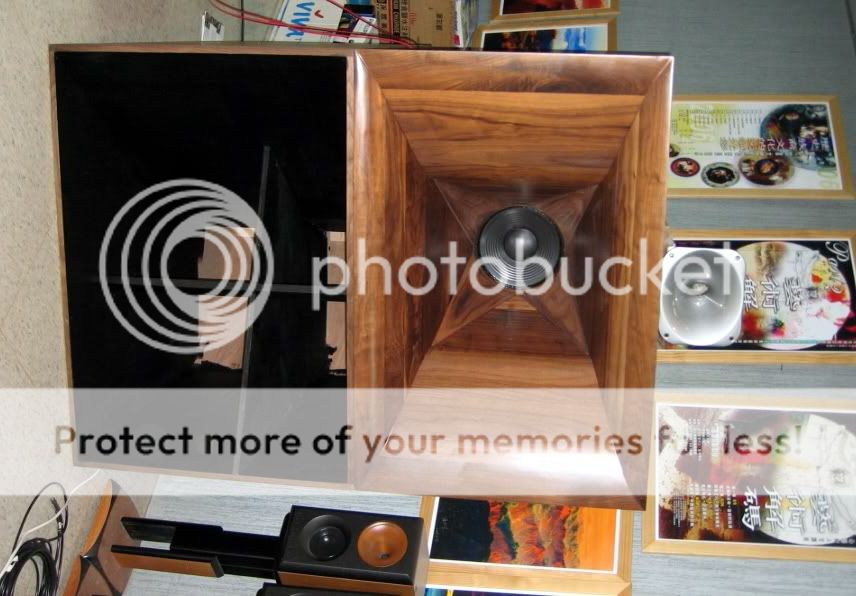
The frequency divisions are now set at 120Hz and 1.2kHz, 24dB/oct. Bessel (by DCX2496). (some other points or combining various curve shoulders can be tried in the future)
Bass horn flare is 30Hz hypo (by the help of hornresp, of course). Thanks to the big throat, so the total length is not very long. The mouth is 120cm wide x 80 cm high. The whole ¡¥cabinet¡¦ is about 1.5m deep. In the simulation, one of my old stuff - EV DL18W fits in very well. Unbelievable well: more than 110dB/2.83V, sub-30Hz to 200Hz! Usable range is 25 ~ 250Hz. (Oh, that¡¦s in 0.5pi condition, but still very impressive)
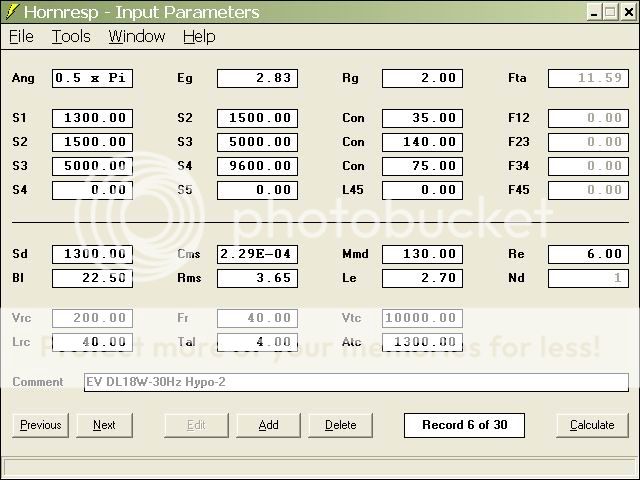
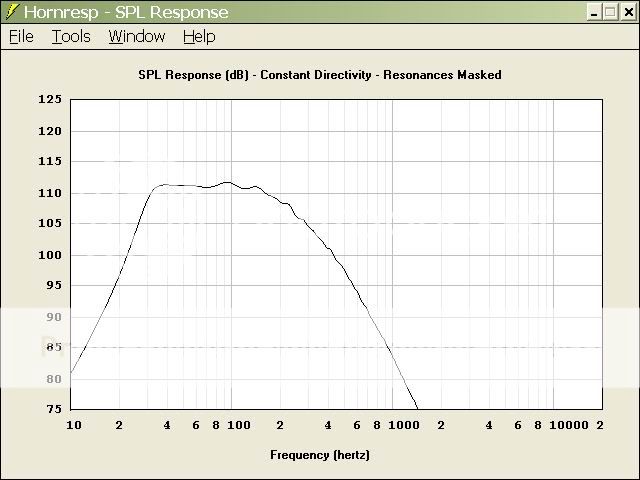
Mid-bass "horn" is designed around TAD TM-1201, and the flare is a mix of conical and exponential with large round-off mouth. Overall contour is very shallow and wide-open for avoiding horn honk, and keep the most of original character of the driver. It provides not much loading, but OK down to about 100Hz region. Hornresp also shows a very early roll-off towards the upper range. Fortunately it's actually way better then simulation with regard of the higher range. I guess it¡¦s because the big throat does not filter out the upper frequency so the driver act more like a direct radiator in that region. The back of the driver is open. So, maybe this is more like a ¡§waveguided OB¡¨ than a ¡§real horn¡¨.
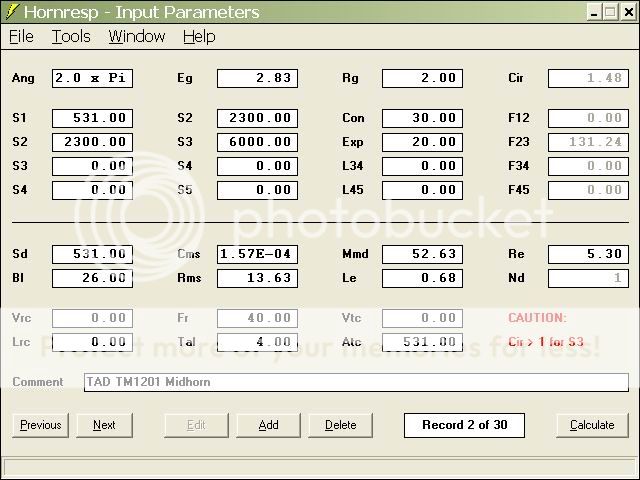

At first I drew an octangle throat on the drawing board. After the first prototyping, the fellow carpenter thought he could do better. So we change that into circular, thus a very big section of round to square conversion. (oh, it¡¦s not actually square, I should say rectangular). After another prototyping, we built this with solid walnut all round. And it¡¦s finished by a professional marine grade coating. Those curvy parts for the big ¡§round to rectangular section¡¨ brought a very hard time to the carpenter. Fortunately it eventually paid off. The 4 radial ¡§rays¡¨ are now the most significant ¡§show off¡¨ factor of the whole appearance. Of course its sheer size is also astonishing, 120cm wide x 80cm high.
Mid-high compression driver is TAD TD-2001 and mated with 18sound's XT1086. They match with each other quite well in the range from 1.2k up and deliver a very smooth and open sound with dynamics and details. And I found the CD horn's decline towards high was not very obvious in this combination.
Time align was adjusted by the auto delay function in the DCX. The results are about 2.4m step back for the mid-bass, and another 44cm for the mid-high. (Oh, I forget the numbers of delay times, those are equivalent distances.) These numbers reflect the physical locations almost perfectly. I guess that is because the curves are all Bessel. (I remember last time I got much longer delays on the LR curves¡K )
The ¡§room¡¨ is not small, estimated 6m wide x 12m deep or so with a very high ceiling. The boundaries are not very proper in acoustics but overall dead and well isolated from the outside. The characters of dead and well isolated of this room are the main reason I focused on the ¡§far more than enough¡¨ sound energy route.
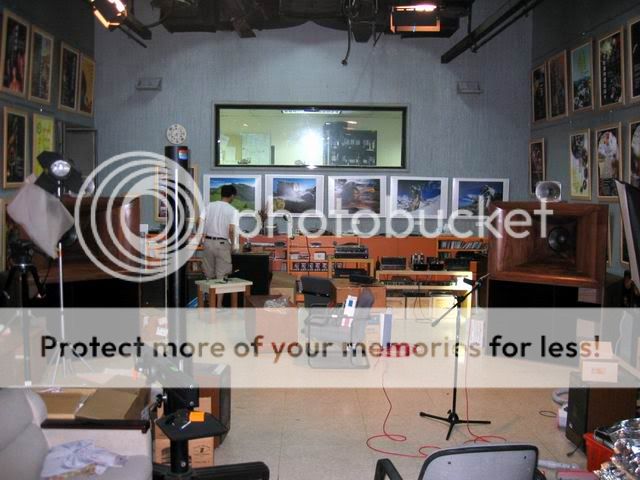
After all the components and links were in positions, the tuning and integration took not much time and the big guy began singing. I think it¡¦s because all three horns are very well behaved and also operating at the right regions so they are all in a very relaxed situation.
Amplifiers are all tubes. Power distribution is 100 / 15 / 5W for L / MB / MH respectively. The combinations may probably be changed in the future, now they work quite well.
Overall sound is just overwhelming! I can say such system is my dream come true. Entire range, bottom to top, is so effortless yet so solid. I think of the breath of a giant. The huge mega massive energy is delivered in a totally effortless way. At proper listening positions (with enough distances of course), its size no longer bothering and the sounds are integrated very well. Oh, someone may be not so used to the height of images, kind of raising head towards the stage. Personally I¡¦m OK with that.
Like heaven, it almost delivers everything. Big and massive of course, but also loads of details and delicate textures. At such size, it surely would not deliver the ¡§pin point¡¨ positioning of those mini monitors. Those effects are cool but not natural and real anyway. All images from this system are slightly bigger than real in most recordings but all well defined and solidly condensed. They are all presented as their body size, shape and weight should be.
Most of all, the sense of ¡§they are here¡¨ is outstanding. At a passage of a violin solo, it¡¦s amazing to get clear transient impacts on the chest! Being at the other end of the room, I thought to myself, what the xxxx?
The feel of physical impacts should be in the very low frequencies, why it showed in a violin solo? Seeing the RTA display revealed the secret. The bottom octave does exist in the violin recording! Listening more carefully, I realized the sub impacts were the bow¡¦s initial presses on the strings, or the moving direction change of the bow. And more frequently they were the thumps when finger tips hammering on the strings. Such coherently fullrange details with excellent energy delivery make the realness so overwhelming. It's almost physical.
On the other hand, one may of course argue that the real violin in person should not have that kind of sub bass impacts. True. What I experienced might be just a ¡§careless¡¨ piece of work by the engineer who picked the wrong mic and forgot to press the button of sub filter. Anyway, this is kind of new to me, I mean, feeling the sub bass impacts from a violin recording.
Wouldn¡¦t that too exaggerated in the bass? No. The mid-bass and bass horn is tightly controlled all the time. Acoustic bass, drums, anything you name it, are so solid and jumping with full impact energy and correct timbre. Both quality and power are excellent. Deep, of course. Bass sound from pipe organ is like a huge rock rolling and crunching along, shaking the ground, with winds flushing alongside.
This is iMAX in audio. I¡¦m shocked, drunk and drowned ¡K
My "client" (also a friend) wanted me to design a big system which can utilize his "good stuff". And he got a partner in business who is a very skillful carpenter, so he urged me to design something not only sounds good but also delivers some visual impact.
So here is, a 3way horn system:

The frequency divisions are now set at 120Hz and 1.2kHz, 24dB/oct. Bessel (by DCX2496). (some other points or combining various curve shoulders can be tried in the future)
Bass horn flare is 30Hz hypo (by the help of hornresp, of course). Thanks to the big throat, so the total length is not very long. The mouth is 120cm wide x 80 cm high. The whole ¡¥cabinet¡¦ is about 1.5m deep. In the simulation, one of my old stuff - EV DL18W fits in very well. Unbelievable well: more than 110dB/2.83V, sub-30Hz to 200Hz! Usable range is 25 ~ 250Hz. (Oh, that¡¦s in 0.5pi condition, but still very impressive)


Mid-bass "horn" is designed around TAD TM-1201, and the flare is a mix of conical and exponential with large round-off mouth. Overall contour is very shallow and wide-open for avoiding horn honk, and keep the most of original character of the driver. It provides not much loading, but OK down to about 100Hz region. Hornresp also shows a very early roll-off towards the upper range. Fortunately it's actually way better then simulation with regard of the higher range. I guess it¡¦s because the big throat does not filter out the upper frequency so the driver act more like a direct radiator in that region. The back of the driver is open. So, maybe this is more like a ¡§waveguided OB¡¨ than a ¡§real horn¡¨.


At first I drew an octangle throat on the drawing board. After the first prototyping, the fellow carpenter thought he could do better. So we change that into circular, thus a very big section of round to square conversion. (oh, it¡¦s not actually square, I should say rectangular). After another prototyping, we built this with solid walnut all round. And it¡¦s finished by a professional marine grade coating. Those curvy parts for the big ¡§round to rectangular section¡¨ brought a very hard time to the carpenter. Fortunately it eventually paid off. The 4 radial ¡§rays¡¨ are now the most significant ¡§show off¡¨ factor of the whole appearance. Of course its sheer size is also astonishing, 120cm wide x 80cm high.
Mid-high compression driver is TAD TD-2001 and mated with 18sound's XT1086. They match with each other quite well in the range from 1.2k up and deliver a very smooth and open sound with dynamics and details. And I found the CD horn's decline towards high was not very obvious in this combination.
Time align was adjusted by the auto delay function in the DCX. The results are about 2.4m step back for the mid-bass, and another 44cm for the mid-high. (Oh, I forget the numbers of delay times, those are equivalent distances.) These numbers reflect the physical locations almost perfectly. I guess that is because the curves are all Bessel. (I remember last time I got much longer delays on the LR curves¡K )
The ¡§room¡¨ is not small, estimated 6m wide x 12m deep or so with a very high ceiling. The boundaries are not very proper in acoustics but overall dead and well isolated from the outside. The characters of dead and well isolated of this room are the main reason I focused on the ¡§far more than enough¡¨ sound energy route.

After all the components and links were in positions, the tuning and integration took not much time and the big guy began singing. I think it¡¦s because all three horns are very well behaved and also operating at the right regions so they are all in a very relaxed situation.
Amplifiers are all tubes. Power distribution is 100 / 15 / 5W for L / MB / MH respectively. The combinations may probably be changed in the future, now they work quite well.
Overall sound is just overwhelming! I can say such system is my dream come true. Entire range, bottom to top, is so effortless yet so solid. I think of the breath of a giant. The huge mega massive energy is delivered in a totally effortless way. At proper listening positions (with enough distances of course), its size no longer bothering and the sounds are integrated very well. Oh, someone may be not so used to the height of images, kind of raising head towards the stage. Personally I¡¦m OK with that.
Like heaven, it almost delivers everything. Big and massive of course, but also loads of details and delicate textures. At such size, it surely would not deliver the ¡§pin point¡¨ positioning of those mini monitors. Those effects are cool but not natural and real anyway. All images from this system are slightly bigger than real in most recordings but all well defined and solidly condensed. They are all presented as their body size, shape and weight should be.
Most of all, the sense of ¡§they are here¡¨ is outstanding. At a passage of a violin solo, it¡¦s amazing to get clear transient impacts on the chest! Being at the other end of the room, I thought to myself, what the xxxx?
The feel of physical impacts should be in the very low frequencies, why it showed in a violin solo? Seeing the RTA display revealed the secret. The bottom octave does exist in the violin recording! Listening more carefully, I realized the sub impacts were the bow¡¦s initial presses on the strings, or the moving direction change of the bow. And more frequently they were the thumps when finger tips hammering on the strings. Such coherently fullrange details with excellent energy delivery make the realness so overwhelming. It's almost physical.
On the other hand, one may of course argue that the real violin in person should not have that kind of sub bass impacts. True. What I experienced might be just a ¡§careless¡¨ piece of work by the engineer who picked the wrong mic and forgot to press the button of sub filter. Anyway, this is kind of new to me, I mean, feeling the sub bass impacts from a violin recording.
Wouldn¡¦t that too exaggerated in the bass? No. The mid-bass and bass horn is tightly controlled all the time. Acoustic bass, drums, anything you name it, are so solid and jumping with full impact energy and correct timbre. Both quality and power are excellent. Deep, of course. Bass sound from pipe organ is like a huge rock rolling and crunching along, shaking the ground, with winds flushing alongside.
This is iMAX in audio. I¡¦m shocked, drunk and drowned ¡K
Thanks 
The mid-high horns are now indeed temporarily placed on top We planned to make a baffle or something, but have not figured it out yet.
We planned to make a baffle or something, but have not figured it out yet.
About the 1201 mid bass, I don't remember seeing any official or 3rd party measurement of it. I guess that 100dB/w rating on datasheet is probably the plateau of the up-tilt response, while that is not shown on the hornresp.
On hornresp, I tried several more configurations of horn or WG for this driver and also got little gain. I'm curious about this too. With so high the BL and so low the Qts, I thought it should do excellent in a horn.
Now I use it below the recommended 200Hz lower limit, and cut its upper end a lot. I found no obvious problem to do so, for now.
Maybe I'll try raising it a bit to see if any good.
The mid-high horns are now indeed temporarily placed on top
About the 1201 mid bass, I don't remember seeing any official or 3rd party measurement of it. I guess that 100dB/w rating on datasheet is probably the plateau of the up-tilt response, while that is not shown on the hornresp.
On hornresp, I tried several more configurations of horn or WG for this driver and also got little gain. I'm curious about this too. With so high the BL and so low the Qts, I thought it should do excellent in a horn.
Now I use it below the recommended 200Hz lower limit, and cut its upper end a lot. I found no obvious problem to do so, for now.
Maybe I'll try raising it a bit to see if any good.
- Status
- This old topic is closed. If you want to reopen this topic, contact a moderator using the "Report Post" button.
- Home
- Loudspeakers
- Multi-Way
- 3way Horn